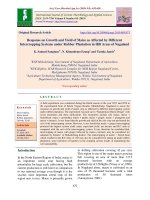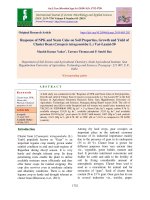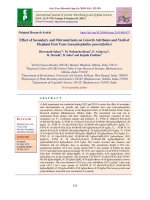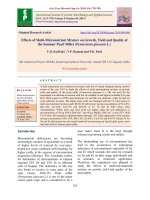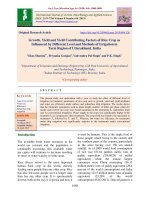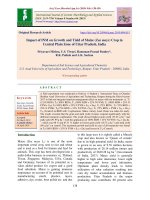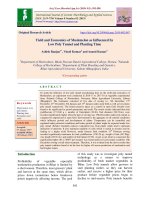Nodulation and yield of pigeonpea based intercropping system as influenced by integrated nutrient management in mollisols of the Tarai region
Bạn đang xem bản rút gọn của tài liệu. Xem và tải ngay bản đầy đủ của tài liệu tại đây (206.8 KB, 7 trang )
Int.J.Curr.Microbiol.App.Sci (2018) 7(8): 3874-3880
International Journal of Current Microbiology and Applied Sciences
ISSN: 2319-7706 Volume 7 Number 08 (2018)
Journal homepage:
Original Research Article
/>
Nodulation and Yield of Pigeonpea Based Intercropping System as
Influenced by Integrated Nutrient Management in
Mollisols of the Tarai Region
Singh Ashutosh1*, Pandey Amit Kumar1, V.K. Singh2 and Singh Umesh1
1
Department of Soil Science and Agricultural Chemistry, Bihar Agricultural University,
Sabour-813210, Bhagalpur (Bihar), India
2
Department of Agronomy, College of Agriculture, G.B. Pant University of Agriculture &
Technology, Pantnagar- 263 145 (Uttarakhand), India
*Corresponding author
ABSTRACT
Keywords
Intercropping system,
PSB, FYM,
Nodulation, Pigeonpea
equivalent yield
Article Info
Accepted:
20 July 2018
Available Online:
10 August 2018
The effect of integrated nutrient management on nodulation and yield of pigeonpea based
intercropping system were investigated. A field experiment was carried out during kharif
season of 2007 and 2008 at N.E. Borlaug Crop Research Centre, Govind Ballabh Pant
University of Agriculture and Technology, Pantnagar, Uttarakhand to assess the effect of
three cropping system (pigeonpea sole, pigeonpea + blackgram and pigeonpea + maize),
two levels of inoculation [with and without phosphorus solubilizing bacteria (PSB)] and
three levels of farm yard manure (0, 2.5 and 5.0 t ha-1) on nodulation and yield of
pigeonpea, blackgram and maize. Eighteen treatment combinations were replicated three
times in a factorial randomized block design. The soil of experimental site is characterized
as upland Mollisols of the Tarai region. Results revealed that intercropping of blackgram
with pigeonpea recorded higher values of nodules characters of pigeonpea such as number
of nodules per plant, nodule fresh weight, nodule dry weight, nodulation index and yields
of pigeonpea and its equivalent over its other counter parts. Similar results were also
obtained with PSB-inoculation and FYM @ 5.0 t ha-1 for nodulation and yield of main &
inter crop.
Introduction
Pulses have played an important role in the
agricultural economy in sustaining the
productivity of soil. Out of major rainfed
pulses, pigeonpea [Cajanus cajan (L.) mill
sp.] is one of the most important pulse crop
grown in India. The low productivity of
pigeonpea in the country may be ascribed to
many reasons, however inadequate and
imbalanced
fertilization,
limited
seed
inoculation, indeterminate growth, flower drop
and dry matter partition are important. It has
potential to give comparable yield under
improved management system. Pigeonpea
have been replaced by short duration and
photo-insensitive cultivars, viz. „UPAS 120‟,
„T21‟, „ICPL 87‟. The cultivation of these
varieties becomes popular because they
provide opportunity for late sown wheat
3874
Int.J.Curr.Microbiol.App.Sci (2018) 7(8): 3874-3880
(Triticum aestivum L. emend.).There is
possibility of growing short duration
intercrops like blackgram (Vigna mungo L.),
greengram and cow pea with pigeonpea, as the
growth of the letter crop plants remain quite
slow with little canopy during early stage
(Rajput et al., 1995).The green revoulation
brought impressive gains in food production
but due to intensive use of agro-chemicals soil
biodiversity is being disturbed. There is now
fabulous pressure on growers to use integrated
nutrient management approach to increase
productivity and soil health. Organic
amendment offers an alternative tactic to
increase
production
(Meena,
2013).
Biofertilizers are cheaper, eco-friendly and
based on renewable energy sources has gained
momentum to supplement the parts of
chemical fertilizer (Meena et al., 2015a).
Inoculation with an effective and persistent
PSB strains has numerous benefits, which
increase the pod yield due to increased
nodulation (Podile, 1995). The use of farmderived source such as FYM has extensively
been used in various crops. These organic
additives can be used to promote the
development of beneficial organisms in the
soil, water holding capacity and cation
exchange capacity (Singh et al., 2008).
Organic amendment also increases the
efficiency of biofertilizers. Therefore, the
present investigation was undertaken to see
the response of „UPAS 120‟ a short duration
pigeonpea cultivar, to study the effect of
integrated nutrient management on nodulation
and yields of component crops in pigeonpea
based intercropping system in Mollisols of
Tarai region.
Materials and Methods
Achallenge was made to study the response of
pigeonpea based intercropping system to
integrated nutrient management on Mollisols.
A field experiment was conducted during
kharif seasons of 2007 and 2008 at N.E.
Borlaug
Crop
Research
Centre,
GovindBallabh Pant University of Agriculture
and Technology, Pantnagar is situated at 29oN
latitude, 79o30‟ E longitude and at an altitude
of 243.83 meter above mean sea level
(M.S.L.) under sub-humid and sub-tropical
climate zone with hot dry summers and cool
winters in Tarai region, 25 km away from the
foot hills of Himalayas. Tarai region remains
dry from early October to mid-June and wet
from mid-June to early October. The
maximum temperature is recorded in MayJune (38oC) and the lowest in DecemberJanuary (4oC) with occasional frost. Relative
humidity is the highest in July (81%) and the
lowest in May (37%). The average annual
rainfall is 1400 mm and most of it is received
during monsoon season between June and
September. The soil of experimental area was
sandy loam in texture with neutral pH (7.2).
Eighteen treatments comprised of three
cropping system (pigeonpea sole, pigeonpea +
blackgram and pigeonpea + maize), two levels
of inoculation (with PSB and without PSB)
and three FYM levels (0, 2.5 and 5 t ha-1) were
tested in factorial randomized block design
with three replications. The crop pigeonpea
(cv. UPAS-120), blackgram (cv. Pant Urd-40)
and maize (cv. Surya) was sown on 2nd and
16th July during 2007 and 2008, respectively.
The plant-to-plant spacing of pigeonpea and
maize was maintained at 20 cm and of
blackgram at 10 cm by thinning out extra
plants at 15 days after sowing. Intercultural
operations i.e. weeding and bird watching
were taken care of during crop growing season
in both the years. After field preparation, a
basal dose of 20 kg N, 40 kg P2O5 and 30 kg
K2O ha-1 to pigeonpea & blackgram and 60 kg
N, 60 kg P2O5 and 40 kg K2O ha-1 to maize
was applied irrespective of fertilizer treatment.
Remaining half amount (60 kg N ha-1) was
top-dressed to maize rows only in two equal
splits at knee height and tasseling stages. The
N, P and K were applied through urea, single
super phosphate and muriate of potash. Seeds
3875
Int.J.Curr.Microbiol.App.Sci (2018) 7(8): 3874-3880
of crops were inoculated with PSB (Bacillus
polymyxa) before sowing. The crop was
sprayed with thiodon + metasystox (1:1 ratio)
by using 700 litres of water ha-1 at 90 DAS
and pod filling stages for the control of
Maruca and Heliothis. Intercrop blackgram
was harvested at 100 and 105 days after
sowing (DAS) while maize was harvested at
94 and 83 DAS during 2007 and 2008,
respectively. The pigeonpea crop was
harvested on 29th December in 2007 and 30th
December in 2008. The experimental site
experienced a total rainfall of 1244.8 and
1667.2 mm during the crop period in 2007 and
2008, respectively.
Five plants were randomly selected in each
plot to count the number of nodules per plant
and weighed to get their fresh weight. The
nodules thus obtained was kept in the petri
dish and dried in the oven at 70 ± 1oC for 48
hours to record the dry weight of nodules per
plant. The nodulation index, which accounts
for the effect of the plant size on nodules
mass, was calculated for each plant sample by
using the formula as suggested by Betts and
Herridge (1987).
Nodule dry weight per plant (g)
Nodulation index = ------------------------ X 100
Dry matter yield per plant (g)
The plants from the net plot area (9.6 square
meters) in each plot were harvested, bundled,
weighed after sun drying.
Thereafter, the materials were threshed and to
record the biological yield (grain + stalk yield)
per plot, which was converted to kg ha-1. The
pigeonpea equivalent yield was calculated by
using following formula:
Pigeonpea equivalent yield (q ha-1) = [Price of
urd/maize x Yield of urd/maize (q ha-1)] /
[Price of pigeonpea] + Yield of pigeonpea (q
ha-1)
All the data were analyzed statistically by
applying ANOVA technique (Panse and
Sukhatme, 1978). The differences among
treatments were compared by applying “F”
test of significance at 5 per cent of probability.
Results and Discussion
Effect of integrated nutrient management
in pigeonpea based intercrop on nodulation
The data pertaining to number of nodules per
plant, fresh weight, dry weight and nodulation
index of pigeonpea are furnished in table 1.
The number of nodules, fresh and dry weight
of nodules per plant and nodulation index in
pigeonpea significantly increased under
pigeonpea + blackgram intercropping system
compared to sole and pigeonpea + maize
intercropping. Higher values of no. of nodules
(11.68 and 11.2), nodule fresh weight (169.0
and 154.67 mg plant-1), nodule dry weight
(17.85 and 15.66 mg plant-1) and nodulation
index (0.2053 and 0.2056) in pulse + pulse
intercropping system during both the years.
Better nodulation and more fresh and dry
weight occurred in pigeonpea + blackgram
intercrop of pigeonpea that might be attributed
to better photosynthesis and translocation of
photosynthate to root nodules, because of
adequate light and space. These results are in
secure accord with the findings of Singh and
Faroda (1986).
The enhancement in nodulation in terms of
nodule, their fresh and dry weight and
nodulation index per plant of pigeonpea were
obtained by the efficiency of inoculated of
Bacillus polymyxa in the results in both the
years over uninoculated control. PSBinoculation resulted in significant increase in
nodule number, their fresh and dry weight and
nodulation index of pigeonpea (9.08, 119.56
mg, 13.92 mg and 0.1763 in 2007 and 8.57,
111.22 mg, 12.21 mg&0.1808 in 2008),
respectively.
3876
Int.J.Curr.Microbiol.App.Sci (2018) 7(8): 3874-3880
Table.1 Nodules number, fresh weight, dry weight and nodulation index of pigeonpea as influenced by integrated nutrient
management in pigeonpea based intercropping system
Treatment
No. of Nodules per
plant
Nodule Fresh Weight
(mg plant-1)
Nodule Dry Weight
(mg plant-1)
Nodulation Index
2007
2008
2007
2008
2007
2008
2007
2008
Sole pigeonpea
9.32
8.78
110.00
101.83
14.06
12.33
0.1831
0.1867
Pigeonpea + Blackgram
11.68
11.02
169.00
154.67
17.85
15.66
0.2053
0.2056
Pigeonpea + Maize
3.99
3.80
39.33
37.00
6.34
5.56
0.1128
0.1157
S.Em.±
0.18
0.17
2.37
2.01
0.22
0.19
0.0018
0.0017
CD (5%)
0.51
0.48
6.82
5.78
0.62
0.54
0.0053
0.0050
With PSB
9.08
8.57
119.56
111.22
13.92
12.21
0.1763
0.1808
Without PSB
7.58
7.17
92.67
84.44
11.58
10.16
0.1578
0.1579
S.Em.±
0.15
0.14
1.94
1.64
0.18
0.15
0.0015
0.0014
CD (5%)
0.42
0.39
5.57
4.72
0.50
0.44
0.0043
0.0042
0
6.36
6.00
62.33
58.33
9.69
8.50
0.1449
0.1530
2.5
8.09
7.63
105.17
95.33
12.31
10.79
0.1626
0.1653
5.0
10.55
9.97
150.83
139.83
16.26
14.26
0.1937
0.1897
S.Em.±
0.18
0.17
2.37
2.01
0.22
0.19
0.0018
0.0017
CD (5%)
0.51
0.48
6.82
5.78
0.62
0.54
0.0053
0.0050
CV (%)
9.08
9.01
9.49
8.72
7.15
7.06
4.69
4.44
A. Cropping System
B. PSB inoculation
C. FYM levels (t ha-1)
3877
Int.J.Curr.Microbiol.App.Sci (2018) 7(8): 3874-3880
Table.2 Grain yield of component crops and pigeonpea equivalent yield as influenced by integrated nutrient management in
pigeonpea based intercropping system
Yield (Kg ha-1)
Treatment
Pigeonpea
Blackgram
Maize
Pigeonpea Equivalent
2007
2008
2007
2008
2007
2008
2007
2008
Sole pigeonpea
1631
1394
-
-
-
-
1631
1294
Pigeonpea + Blackgram
1833
1484
597
486
-
-
2476
2096
Pigeonpea + Maize
1057
820
-
-
2557
2047
2036
1679
S.Em.±
57
48
-
-
-
-
67
57
CD (5%)
163
137
-
-
-
-
193
164
With PSB
1581
1260
641
526
2760
2217
2164
1791
Without PSB
1432
1139
553
446
2353
1876
1931
1589
S.Em.±
46
39
24
23
120
94
55
47
CD (5%)
133
112
77
71
379
296
158
134
0
1290
999
463
362
2054
1666
1718
1384
2.5
1492
1189
558
457
2645
2049
2030
1668
5.0
1738
1410
771
640
2972
2424
2395
2018
S.Em.±
57
48
30
28
148
115
67
57
CD (5%)
163
137
94
87
465
362
193
164
CV (%)
16.01
16.82
12.26
13.98
14.13
13.74
13.91
14.34
A. Cropping System
B. PSB inoculation
C. FYM levels (t ha-1)
3878
Int.J.Curr.Microbiol.App.Sci (2018) 7(8): 3874-3880
Podile (1995) also found increasing nodulation
in pigeonpea (18-24%) by the inoculation of
seeds with Bacillus subtilis over control. This
may be due to produce many plant growthpromoting substance like IAA, gibberellic acids
and vitamins etc., which help in the synthesis of
nodular tissue.
Application of FYM brought about significant
changes in no. of nodules, fresh & dry weight
and nodulation index during both the years. The
increased fresh and dry weight of nodules under
higher doses of FYM might be because of
beneficial effects of FYM on number of nodules
assuming that FYM has direct role in biological
nitrogen fixation in legumes, by increasing the
nodules weight of pigeonpea and intercrop
blackgram. Sufficient amount of FYM also
enhanced the activities of Rhizobia and
increased the formation of nodules. Singh et al.,
1998 and Singh et al., 2008 also reported
similar findings.
Effect of Integrated Nutrient Management in
pigeonpea based intercrop on yields of
component crops and pigeonpea equivalent
Data in respect of grain and straw yield of
pigeonpea and intercrop (blackgram and maize)
are presented in table 2. Significantly higher
grain yield (1833 and 1484 kg ha-1) of
pigeonpea was obtained under pigeonpea +
blackgram cropping system during both the
years as compare to its sole crop (1631 and
1294 kg ha-1) and intercrop with maize (1057
and 820 kg ha-1). This might be due to
complimentary effect of blackgram, which
supplemented nitrogen to pigeonpea, and the
better utilization of environmental resources in
the intercropping system. On the contrary,
maize intercropped with pigeonpea had adverse
effect on pigeonpea yield resulting in significant
reduction in grain yield (54 and 58%) as
comparable to the sole pigeonpea. This might
be due to poor dry matter accumulation of
pigeonpea crop and vigorous growth of
component cereal like maize (Singh and Pal,
2003). Seed inoculation with phosphorus
solubilizing biofertilizer recorded significantly
improvement in grain yield of pigeonpea (1581
and 1260 kg ha-1) and intercrops viz., blackgram
(641 and 526 kg ha-1) and maize (2760 and
2217 kg ha-1) as compared to uninoculation in
2007 and 2008, respectively. This may be due
to ability of PSB in producing indole acetic
acid, solubilization of tricalcium phosphate,
inhibition of Aspergillus flavus and Aspergillus
niger in vitro and best in rhizosphere colonizer,
which enhanced yield attributing characters of
crops and finally the grain yields. These results
are in close conformity with those of Reddy et
al., 2000.
Grain yield of pigeonpea (1738 and 1410 kg
ha-1) and intercrop blackgram (771 and 640 kg
ha-1)/ maize (2972 and 2424 kg ha-1) was
significantly higher when 5.0 t FYM ha-1 was
applied to crops in 2007 and 2008, respectively.
However, application of only chemical fertilizer
(no FYM) caused significant reduction in grain
yield of crops during both the years. Since FYM
forms different organic complexes with the
metal cations, it helps in decreasing their losses
from the system. This could have helped in
manipulation of nodulation and yields.
Erikson and Mortensen (1999) also reported
similar findings. The maximum productivity in
terms of pigeonpea grain equivalent yield was
recorded with pigeonpea + blackgram (2476
and 2096 kg ha-1) which was significantly
superior to pigeonpea + maize (2036 + 1679 kg
ha-1) and sole pigeonpea (1631 and 1294 kg ha1
) in both the years. The higher grain equivalent
yield under intercropping system might be
attributed to additional advantage of intercrop
yield and their support rice (Reddy et al., 2007).
Similarly, PSB-inoculation and application also
increase the pigeon equivalent yield.
Acknowledgement
We thanks to the Director of the N. E. Borlaug
Experiment Station, G.B. Pant University of
Agriculture & Technology, Pantnagar-263 145
for providing financial assistance and Dr. V. K.
Singh, University Professor for his valuable
comments, suggestions and publication.
3879
Int.J.Curr.Microbiol.App.Sci (2018) 7(8): 3874-3880
References
Betts, G. S. and Herridge, N. J. 1987. Impaired
nodule function in Medicago polymorpha
(L.) infected with alfalfa mosaic virus.
Physiologist 117: 243-250.
Erikson, J. and Mortensen, J. V. 1999.Soil
sulphur status following long-term annual
application of animal manure and mineral
fertilizers. Biology and Fertility of Soils
28: 416-421.
Meena, R. S. 2013. Response to different
nutrient sources on green gram (Vigna
radiata L.) productivity. Indian Journal
of Ecology 40: 353-355.
Meena, R. S., Dhakal, Y., Bohra, J. S., Singh, S.
P., Singh, M. K. and Sanodiya, P. 2015a.
Influence of bioinorganic combinations
on yield, quality and economics of
mungbean.
American
Journal
of
Experimental Agriculture 8: 159-166.
Panse, V. G. and Sukhatme, P. V.
1978.Statistical Methods for Agricultural
Workers, 3rd ed., ICAR Publication, New
Delhi. 347 p.
Podile, A. R. 1995. Seed bacterization with
Bacillus subtilis AF1 enhances seedling
emergence, growth and nodulation of
pigeonpea.
Indian
Journal
of
Microbiology 35: 199-204.
Rajput, O. P., Kumar, Aditya and Sharma,
Rakesh Kumar 1995. Intercropping of
pigeonpea
(Cajanus
cajan)
with
greengram (Phaseolus radiatus) under
varying levels of fertility and plant
population and its residual effect on
succeeding wheat (Triticum aestivum).
Indian Journal of Agronomy 40: 563-566.
Reddy, B., Prabhakar and Swamy, S. Narayana
2000. Effect of farmyard manure, PSB
and phosphorus on yield and economic of
blackgram (Phaseolus mungo). Indian
Journal of Agricultural Sciences 70: 694696.
Reddy, M. Malla, Padmaja, B., Malathi, S. and
Rao, L. Jalapathi 2007. Productivity of
pigeonpea (Cajanus cajan) – based
intercropping systems as influenced by
fertility and pest management practices
under rainfed conditions. Indian Journal
of Agricultural Sciences 77: 205-207.
Singh, Adesh, Singh, V. K., Rana, N. S.,
Kumar, Sanjay, Panwar, G. S. and
Kumar, Yogesh 2008. Response of
urdbean to farmyard manure and
phosphorus application under urdbeanwheat cropping sequence. Journal of
Food Legumes 21: 119-121.
Singh, R. C. and Faroda, A. S. 1986.Effect of
cropping systems and phosphorus on
nodulation in pigeonpea and soil fertility.
Indian Journal of Agronomy 31: 203-204.
Singh, S. P., Singh S. P. and Misra, P. K. 1998.
Response of short-duration pigeonpea
(Cajanus cajan) to nitrogen, Rhizobium
inoculation and phosphorus. Indian
Journal of Agronomy 43: 681-684.
Singh, T. and Pal, M. 2003. Growth parameter,
yield attributes and yields of pigeonpea as
influenced by cropping system and
nitrogen + phosphorus level. Annals
Agricultural Research and News Series
24: 755-759.
How to cite this article:
Singh Ashutosh, Pandey Amit Kumar, V.K. Singh and Singh Umesh. 2018. Nodulation and Yield
of Pigeonpea Based Intercropping System as Influenced by Integrated Nutrient Management in
Mollisols of the Tarai Region. Int.J.Curr.Microbiol.App.Sci. 7(08): 3874-3880.
doi: />
3880


